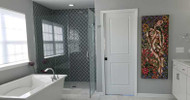Important Facts about Arabesque Tile
Posted by Mike Belk on Jun 22, 2017

Arabesque tiles are a timeless and elegant option in home design, known for their distinct, curvilinear shapes and intricate patterns. Their popularity has grown due to their ability to blend traditional craftsmanship with modern trends, making them a versatile choice for a variety of spaces, including kitchens, bathrooms, living rooms, and outdoor areas. These tiles are available in a wide range of materials, colors, and finishes, offering endless possibilities for homeowners and designers alike.
The History and Origin of Arabesque Tiles
Arabesque tiles have their roots in Islamic art and architecture, where they were originally used to decorate palaces, mosques, and other important structures. The word "arabesque" refers to the intricate, flowing designs that often resemble the repeating patterns of leaves, vines, and flowers. These designs were inspired by the natural world and are characterized by their geometric precision and rhythmic repetition.

In Islamic culture, the use of arabesque patterns was seen as a reflection of the infinite nature of the universe, with the continuous, interlocking shapes symbolizing unity and order. Over time, these patterns made their way into tile design, and the distinctive arabesque tile shape became synonymous with luxury and elegance.
Top 5 Materials and Finishes for Arabesque Tiles:
Arabesque tiles are available in a variety of materials, each offering a unique look and feel. The most common materials include:
1. Ceramic Arabesque Tiles
Ceramic tiles are a popular choice for arabesque designs due to their durability and versatility. They are available in a wide range of colors and finishes, from glossy to matte, and can be easily incorporated into both traditional and modern spaces. Ceramic arabesque tiles are also easy to clean, making them ideal for kitchens and bathrooms where moisture and spills are common.
2. Porcelain Arabesque Tiles
Porcelain is another durable and water-resistant material, making it an excellent option for high-traffic areas and wet environments. Porcelain arabesque tiles are often chosen for their strength and resistance to stains, scratches, and moisture. They are available in various textures, from smooth to textured finishes, and can mimic the appearance of natural stone, marble, or wood.
3. Glass Arabesque Tiles
Glass tiles add a luxurious, reflective quality to any space. Glass arabesque tiles are often used in backsplashes, showers, and accent walls to create a bright, shimmering effect. Available in a range of colors, from soft pastels to bold jewel tones, glass arabesque tiles can enhance the ambiance of a room by reflecting light and adding depth. They are also easy to clean and maintain, making them a practical choice for high-moisture areas.
4. Natural Stone Arabesque Tiles
For a more rustic or organic look, natural stone arabesque tiles are a popular choice. These tiles can be made from materials like marble, travertine, or limestone, offering a timeless and sophisticated aesthetic. Natural stone arabesque tiles often have a textured surface that adds visual interest and depth, making them perfect for creating a luxurious yet earthy feel in any room. The unique veining and color variations in natural stone also ensure that no two tiles are exactly alike.
5. Metal Arabesque Tiles
Metal arabesque tiles, typically made from stainless steel, copper, or aluminum, bring a modern, industrial edge to traditional arabesque patterns. These tiles are often used in contemporary kitchens and bathrooms, where their sleek and shiny surfaces add a touch of glamour and sophistication. Metal arabesque tiles are also durable and easy to maintain, making them a practical choice for areas prone to moisture and heat.
Top 3 Colors and Patterns of Arabesque Tiles:
The color and pattern of arabesque tiles play a significant role in the overall design and aesthetic of a space. Depending on the material, arabesque tiles are available in a wide range of hues, from neutral shades like white, gray, and beige to more vibrant colors like blue, green, and red. The choice of color can significantly impact the mood and atmosphere of a room.
1. Neutral Tones
Neutral-colored arabesque tiles, such as white, cream, and gray, are often used in minimalist and contemporary spaces. These colors create a clean, fresh look that complements a variety of interior styles. White arabesque tiles, for example, are a classic choice for kitchen backsplashes and bathroom walls, offering a timeless and elegant appearance that brightens the space.
2. Bold Colors
For those looking to make a statement, arabesque tiles in bold colors like deep blue, emerald green, and rich burgundy can add drama and sophistication to a room. These vibrant hues are often used as accent tiles in backsplashes or feature walls, drawing attention and creating a focal point. Bold-colored arabesque tiles are particularly popular in Moroccan-inspired designs, where rich jewel tones are a key element of the aesthetic.
3. Patterned Arabesque Tiles
In addition to solid colors, arabesque tiles are available in patterned designs that can add a layer of intricacy and detail to a space. These patterns can range from simple geometric motifs to more elaborate floral and vine designs. Patterned arabesque tiles are often used in bathrooms and kitchens to create a statement backsplash or as an accent tile that contrasts with simpler, more neutral surroundings.
Top 5 Applications of Arabesque Tiles:
Arabesque tiles can be used in a variety of applications throughout the home, from kitchens and bathrooms to living rooms and outdoor areas. Their versatility and timeless design make them suitable for both large-scale installations and small accent pieces.
1. Kitchen Backsplashes
One of the most popular uses of arabesque tiles is in kitchen backsplashes. The intricate shape and design of arabesque tiles add texture and visual interest to an otherwise functional area of the kitchen. Whether used in a traditional or modern kitchen, arabesque tiles can elevate the space by adding a touch of elegance and charm. Glass arabesque tiles are especially popular in kitchens due to their ability to reflect light and create a bright, open feel.
2. Bathroom Walls and Showers
Arabesque tiles are a natural choice for bathrooms, where their curvilinear design adds a sense of luxury and tranquility. These tiles can be used on shower walls, as an accent around a vanity, or to cover the entire bathroom wall. The variety of materials available, such as porcelain, ceramic, and glass, ensures that arabesque tiles can withstand the moisture and humidity typical in bathrooms. Lighter shades of arabesque tiles can make a small bathroom feel more spacious, while darker colors add drama and contrast.
3. Fireplace Surrounds
Arabesque tiles can also be used to create stunning fireplace surrounds. The intricate, repeating pattern of arabesque tiles adds a unique design element that draws attention to the fireplace as a focal point. Whether using natural stone for a rustic feel or glass tiles for a more contemporary look, arabesque tiles can enhance the overall aesthetic of the living room or any other area where the fireplace is located.
4. Accent Walls
For homeowners looking to make a bold design statement, arabesque tiles can be used to create an eye-catching accent wall. Whether installed in a living room, dining room, or entryway, an accent wall covered in arabesque tiles adds texture, pattern, and color to the space. Glass or metallic arabesque tiles are especially effective in creating a shimmering, reflective surface that becomes the focal point of the room.
5. Outdoor Spaces
Arabesque tiles can also be used in outdoor spaces, such as patios, pool areas, and outdoor kitchens. Porcelain and natural stone arabesque tiles are ideal for outdoor applications due to their durability and resistance to weathering. These tiles can be used to create a beautiful outdoor backsplash, accent wall, or even flooring that adds a touch of elegance to the outdoor living area.
4 Benefits of Using Arabesque Tiles:
Arabesque tiles offer several benefits that make them a popular choice among homeowners and designers:
1. Timeless Design
The classic and intricate shape of arabesque tiles has been used for centuries, and their appeal shows no signs of fading. Arabesque tiles offer a timeless design that can be adapted to fit both traditional and contemporary interiors, ensuring that they will remain stylish for years to come.
2. Versatility
Arabesque tiles are incredibly versatile and can be used in a variety of spaces, from kitchens and bathrooms to living rooms and outdoor areas. They are available in a wide range of materials, colors, and finishes, allowing homeowners to customize their look to suit their specific design preferences.
3. Durability
Depending on the material, arabesque tiles are highly durable and resistant to wear and tear. Porcelain, ceramic, and natural stone tiles are particularly strong and can withstand the demands of high-traffic areas, moisture, and heat.
4. Easy Maintenance
Arabesque tiles are relatively easy to maintain, especially when made from materials like ceramic, porcelain, or glass. They are resistant to stains and moisture, making them an ideal choice for areas like kitchens and bathrooms where spills and splashes are common.
Conclusion
Arabesque tiles offer a beautiful and timeless design option for homeowners looking to add elegance and sophistication to their spaces. With a wide range of materials, colors, and patterns available, arabesque tiles can be customized to suit any style, whether traditional, contemporary, or eclectic. From kitchen backsplashes and bathroom walls to fireplace surrounds and outdoor patios, arabesque tiles provide a versatile and durable solution that will enhance the aesthetic and functionality of any space.
Their intricate design, durability, and ease of maintenance make arabesque tiles a smart and stylish investment for both large and small-scale home improvement projects. Whether you're aiming to create a bold statement or add a subtle touch of elegance, arabesque tiles are a perfect choice that will stand the test of time.



